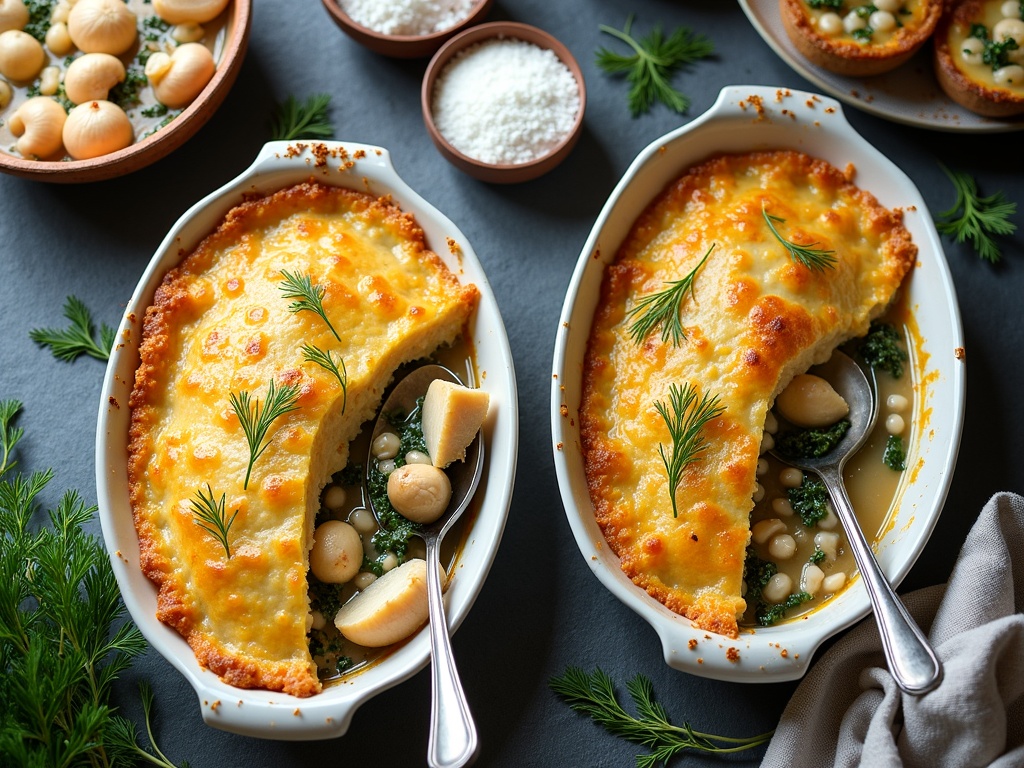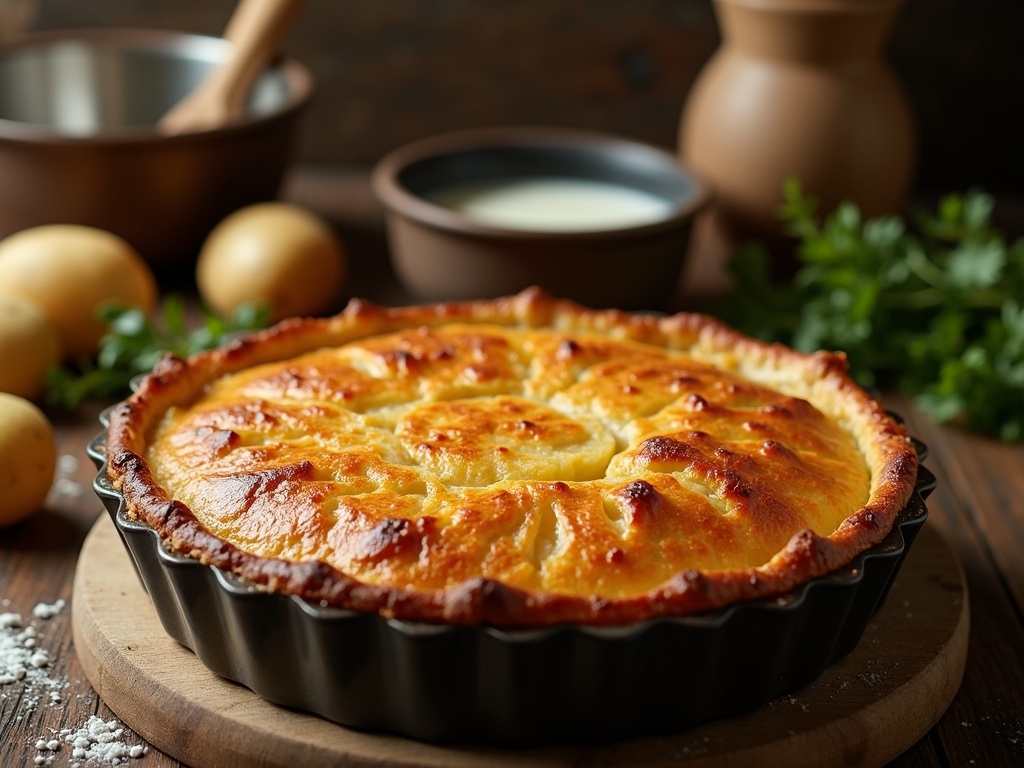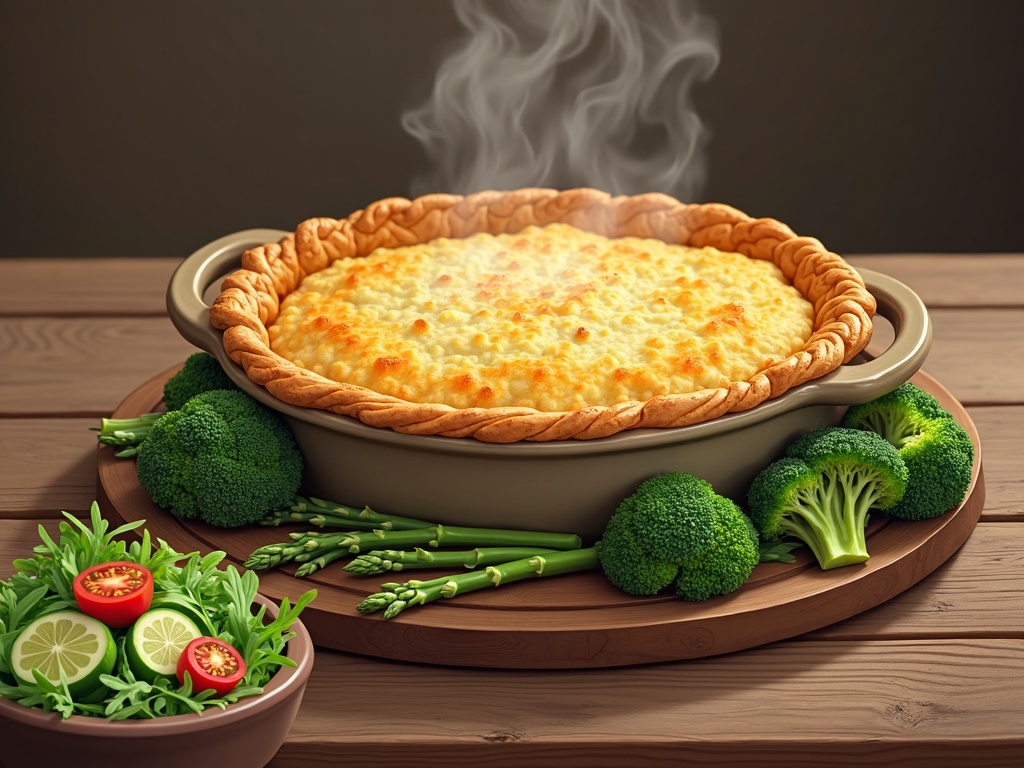Fish pie recipe combines flaky white fish, succulent shellfish, and vegetables in a velvety sauce topped with creamy mashed potatoes for a complete comfort meal. The dish offers impressive nutritional benefits including high-quality protein, omega-3 fatty acids, and essential vitamins while allowing for numerous variations to accommodate different dietary needs and flavor preferences.
Find In This Article
Key Takeaways
- Cod and haddock form an excellent base for fish pie, with the addition of prawns or mussels elevating the flavor profile significantly.
- Poaching fish in milk creates a flavorful base for the creamy sauce, with the technique of adding milk gradually to a roux ensuring a smooth, lump-free consistency.
- A typical serving contains 400-500 calories with approximately 35g of protein, plus beneficial omega-3 fatty acids, vitamins D and B12, and minerals like selenium and iodine.
- The recipe can be adapted for dietary restrictions by substituting mushrooms and spinach for a vegetarian version or using cornstarch instead of flour for gluten-free options.
- Fish pie freezes exceptionally well, making it perfect for meal prep, while complementary sides like bright green vegetables or a crisp salad balance the dish’s richness.
The Perfect Fish Selection for Your Pie
Selecting the right fish for a fish pie can make all the difference between a good meal and a truly memorable one. I’ve found that starting with a combination of white fish creates the perfect foundation for this classic comfort dish.
Best Fish Combinations for Maximum Flavor
Cod and haddock are my go-to choices for fish pie as they provide a wonderfully flaky texture and mild flavor that carries other ingredients beautifully. For a family-sized pie serving 4 people, I recommend using about 500g of fish fillets combined. This proportion ensures each bite contains generous chunks of fish without overwhelming the other components.
To elevate your fish pie from good to exceptional, consider adding about 200g of shellfish. Prawns work exceptionally well, adding a sweet, distinct flavor that contrasts nicely with the white fish. If you’re feeling adventurous, mussels can add remarkable depth to the overall taste profile.
The Marine Conservation Society ranks cod as the top market choice in the UK, and with good reason. Its firm texture holds up well during cooking, making it perfect for pie fillings where you want distinct pieces rather than a mushy texture.
For balance and added nutrition, I include 150-200g of vegetables in my fish pie mixture. Finely chopped onions and sliced leeks create a savory base, while peas add pops of sweetness and color. These vegetables complement the fish without competing with it.
The perfect fish pie isn’t just about the seafood itself but how these elements work together. Here are some winning combinations I’ve tested:
- Equal parts cod and haddock (250g each) with 100g prawns and 100g mussels
- 300g cod, 200g smoked haddock, and 200g prawns for a slightly smokier profile
- 400g cod with 100g salmon and 200g prawns for a richer flavor
If you’re looking for inspiration for other pastry-based dishes, you might enjoy trying chicken and mushroom pie or salmon en croute which use similar techniques but different flavor profiles.
For those who prefer poultry over seafood, a traditional chicken pie follows many of the same principles but with different proteins.
The quality of your fish makes a significant difference in the final result. I always look for sustainably sourced options with firm flesh and no strong fishy smell – these are indicators of freshness that will translate to better flavor in your finished pie.
Creating the Signature Creamy Sauce
The creamy sauce is what elevates a fish pie from good to outstanding. I’ve perfected this sauce through years of testing, and it’s all about getting that silky texture that coats the fish perfectly without overpowering it.
Poaching and Sauce Preparation
First, I poach the fish in milk for about 10 minutes until it flakes easily with a fork. This gentle cooking method not only ensures tender fish but infuses the milk with delicate seafood flavors. This flavored milk becomes the base for our sauce, adding depth that store-bought stock can’t match.
Once the fish is done, I carefully remove it from the milk and set it aside. Now for the magic part – creating a roux as the foundation of our sauce. In a heavy-bottomed pan, I melt 50g of butter over medium heat, then add 50g of flour, stirring constantly until it forms a paste. This mixture prevents lumps and creates the perfect thickening agent.
The key technique here is adding the poaching milk gradually while whisking continuously. I pour in about a quarter cup at a time, incorporating each addition fully before adding more. This patience pays off with a smooth, lump-free sauce. The sauce needs about 5 minutes of gentle simmering to reach the ideal thickness – it should coat the back of a wooden spoon but still flow easily.
When combining the sauce with the fish and vegetables, I fold everything together gently to keep those beautiful chunks of fish intact. This creates a more interesting texture in the finished pie filling with creamy sauce that’s worth the extra care.
For those who enjoy seafood flavors in creamy dishes, this sauce works perfectly with various fish combinations. My favorite mix includes cod, salmon, and a handful of shrimp for varied textures and flavors.
The complete fish pie needs about an hour in total cooking time, including the preparation of this sauce. I bake it at 190°C (375°F) until the top turns golden and the filling bubbles around the edges. This creates that irresistible contrast between the crispy topping and the velvety sauce beneath, similar to what you’d find in a traditional savory pie recipe.
For a twist on the classic, try using this same sauce technique for a salmon pastry dish – the creamy sauce works beautifully as a layer between the fish and pastry, preventing dryness and adding flavor.
Health Benefits of Your Fish Pie Recipe
Fish pie isn’t just comfort food—it’s packed with nutritional benefits that make it a smart choice for your dinner table. A typical serving contains 400-500 calories, making it a reasonable option for those watching their caloric intake while still enjoying a satisfying meal.
Nutrient-Rich Profile
The protein content in fish pie is impressive, with approximately 35g per serving. This makes it an excellent option for muscle maintenance and overall body function. I’ve found that this high protein content helps keep me fuller longer, reducing the temptation to snack between meals.
Fish pie’s star ingredient delivers significant omega-3 fatty acids, which support heart and brain health. These essential fats aren’t produced by our bodies, so including omega-3 rich foods like salmon en croute or fish pie in your diet becomes even more important.
The nutritional benefits extend beyond protein and healthy fats. Fish pie offers a substantial dose of vitamins D and B12. Vitamin D plays a crucial role in calcium absorption and immune function, while B12 is essential for nerve health and energy production. For those who don’t get much sun exposure, these food sources of vitamin D are particularly valuable.
Mineral content is another advantage of this dish. Fish pie is high in:
- Selenium, which supports thyroid function and acts as an antioxidant
- Iodine, crucial for proper thyroid hormone production
- Various other trace minerals that support overall health
I’ve noticed that adding vegetables to my seafood recipes like fish pie increases the fiber content significantly. This added fiber supports digestive health and helps maintain steady blood sugar levels after eating.
For those looking to maximize nutritional value while enjoying comfort food, fish pie strikes an excellent balance. It offers similar benefits to other fish-based dishes like chicken and mushroom pie but with the added advantages of marine-based nutrients.
The versatility of fish pie also allows for healthy adaptations. I often recommend using low-fat milk or adding extra vegetables to boost the nutritional profile even further. Similar adaptations can work well in chicken pie recipes too.
With its balance of calories, protein, essential fats, vitamins, and minerals, fish pie represents a nutritionally complete meal option that supports your overall health while satisfying your taste buds.
Make It Your Own: Variations and Dietary Options
I’ve found that fish pie is incredibly versatile and can be adapted to suit various dietary needs and taste preferences. Whether you’re cooking for someone with specific requirements or simply want to experiment with flavors, these variations will help you customize this classic dish.
Dietary Adaptations
For those following a vegetarian diet, I’ve created a delicious alternative that doesn’t compromise on flavor or texture. Replace the fish with a hearty combination of mushrooms and spinach. Portobello or oyster mushrooms work exceptionally well as they provide a meaty texture, while spinach adds color and nutrients. I often sauté the mushrooms until golden before mixing them with wilted spinach and folding them into the creamy sauce.
Creating a gluten-free version is straightforward too. Instead of using flour to thicken the sauce, substitute with cornstarch. The key difference is in the technique – mix the cornstarch with a small amount of cold water first, then add it to the warm milk mixture, stirring continuously until thickened. This prevents any lumps from forming and creates a silky-smooth sauce that’s completely gluten-free.
If you’re looking for something different but still want to enjoy the seafood elements, consider trying a seafood chowder which offers similar comfort food qualities with a different presentation.
Flavor Enhancements and Storage Options
I’ve discovered that herbs can transform the flavor profile of a fish pie dramatically. Adding fresh dill gives the dish a distinctly Scandinavian touch that pairs beautifully with salmon, while tarragon lends a subtle aniseed note that complements white fish perfectly. Don’t be afraid to experiment with herb combinations – a tablespoon of fresh chopped herbs stirred into the sauce just before assembling can elevate your pie to restaurant quality.
Fish pie freezes remarkably well, making it perfect for meal prep. After cooking, allow the pie to cool completely, then portion and freeze for up to three months. I recommend using individual oven-safe containers for easier reheating. When ready to eat, thaw overnight in the refrigerator and reheat in a 350°F oven until piping hot throughout.
Batch cooking this dish saves significant time on busy weeknights. I often make a double batch, serving one immediately and freezing the other for future meals. It’s especially handy when expecting guests – simply defrost and reheat for a homemade meal without the last-minute cooking stress.
For a quicker weeknight alternative, my chicken and mushroom pie uses similar techniques but with different proteins. Similarly, a chicken pie recipe can be adapted using the same principles discussed here.
If you’re feeling adventurous, consider a salmon en croute as another elegant way to serve fish with a pastry element, though with a different presentation style than traditional fish pie.
I’ve found that fish pie is an excellent canvas for creativity. The basic formula – protein, creamy sauce, and potato topping – remains the same, but the individual elements can be swapped and tweaked to your heart’s content. Whether you’re accommodating dietary restrictions or simply playing with new flavor combinations, this adaptable dish continues to earn its place as a beloved comfort food that never goes out of style.

Perfect Pairings and Presentation
The right accompaniments can elevate a fish pie from a hearty main dish to a complete meal experience. I’ve found that balancing the richness of this classic comfort food with lighter sides creates the perfect dining harmony.
Complementary Side Dishes
Vibrant green vegetables offer both nutritional balance and visual appeal alongside a golden-topped seafood dish like fish pie. Steamed broccoli florets retain their bright color and slight crunch when prepared correctly, providing a refreshing contrast to the creamy texture of the pie. Asparagus spears, particularly when in season, add an elegant touch to the plate while contributing earthy notes that complement the delicate fish flavors.
For a lighter option, a crisp side salad works wonders. I recommend a simple combination of:
- Peppery arugula leaves tossed with a light lemon vinaigrette
- Thinly sliced cucumber and radish for refreshing crunch
- Cherry tomatoes for bursts of acidity
- A sprinkle of fresh herbs like dill or parsley to echo flavors in the pie
The color contrast between the golden-brown topping of your salmon or white fish pie and the vibrant green vegetables creates an instantly appetizing presentation. This visual appeal makes the dish even more inviting before the first bite.
One of the greatest advantages of a well-made fish pie is its make-ahead potential. I often prepare mine a day in advance, allowing the flavors to develop overnight in the refrigerator before baking. For longer storage, fish pie freezes remarkably well when properly wrapped. The key is to freeze it before the final baking stage, then thaw completely in the refrigerator before cooking.
What’s particularly impressive is how a quality savory pie maintains its taste integrity even after freezing. Unlike many seafood dishes that can suffer textually when stored, the protective sauce and potato topping help preserve the delicate fish textures. Just ensure it’s stored in airtight containers to prevent freezer burn.
When serving a previously frozen fish pie, I find adding a fresh element—like newly chopped herbs or a lemon wedge—brings back that just-made feeling. This approach gives you the convenience of a homemade pie with minimal last-minute preparation, perfect for entertaining or busy weeknights when you still want something special on the table.
Kitchen Tips for Success
Creating a perfect fish pie isn’t just about following the recipe—it’s about mastering a few key techniques that transform a good dish into an exceptional one. I’ve learned some valuable tricks over years of making this comforting classic that’ll help you achieve fish pie perfection.
Essential Techniques for the Perfect Result
When assembling your fish pie, handle the fish with care. I gently fold the fish pieces into the sauce rather than stirring vigorously. This preserves the delicate texture of the fish, ensuring you get distinct, flaky chunks in every bite rather than a mushy filling.
For the mashed potato topping, 1kg of potatoes creates the ideal proportion for a standard family-sized pie. This amount provides enough coverage to form a golden crust while maintaining a good fish-to-potato ratio. I’ve found that floury varieties like Russets or King Edwards create the fluffiest mash for topping a savory pie with creamy filling.
Here are some time-saving tricks I use for better results:
- Save the milk used for poaching the fish to make your sauce—it’s packed with flavor and reduces waste
- Create texture on top of your mash with a fork before baking for more crispy edges
- Add a sprinkle of cheese during the last 10 minutes of baking for extra flavor
- Monitor the pie during the final cooking stage—you’re looking for a golden-brown crust, not dark brown
- Let your homemade pie rest for 5-10 minutes before serving to allow the filling to set slightly
When making the sauce, I gradually add the reserved poaching milk to prevent lumps from forming. This technique creates a silky base that perfectly coats the seafood mixture without being too runny or thick.
The final step is crucial—allowing your fish pie to rest after baking. This brief pause lets the filling settle and thicken slightly, making it easier to serve picture-perfect portions. It’s tempting to dive right in, but those few minutes make a noticeable difference in the final presentation, just like with a beautifully prepared salmon dish.

Sources:
Fish Pie: The Perfect Comfort Food by BBC Good Food
Nutrition on the Plate: Fish Benefits by Healthline
Innovative Fish Recipes for Home Cooking by The Marine Conservation Society

